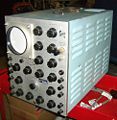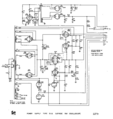511: Difference between revisions
No edit summary |
No edit summary |
||
| Line 12: | Line 12: | ||
The 511A weighs 50 pounds and uses 230 watts. | The 511A weighs 50 pounds and uses 230 watts. | ||
Neither the 511 nor the 511A has a [[thermal cutoff]]. | Neither the 511 nor the 511A has a [[thermal cutoff]]. | ||
Tektronix engineer Frank Hood recollects: | |||
<blockquote>"My first assignment was to build or modify some special instruments for Bonneville Power. They wanted a device that would detect and record any lightning strikes or arc-overs on the high voltage power lines running between Vancouver, Wash. and other cities such as Longview, Spokane, etc. They wanted to detect each event, in a fraction of a millionth of a second, then to send a pulse of energy down the defective line and measure the time it took to return, (this was an application much like radar). They wanted markers displayed at each mile and fraction of a mile so that they could determine the exact location of the fault. They needed to record a photographic image for latter study. Two or more such instruments were built. We called these Type 511B. They worked very well and were used for several years." | |||
</blockquote> | |||
The 511 and 511A were normally furnished with P1 [[phosphor]]. | The 511 and 511A were normally furnished with P1 [[phosphor]]. | ||
Revision as of 13:29, 31 December 2011
The 511 was Tek's first product, introduced in 1947. A revised version, the 511A, was introduced in 1950. Charles Vollum was directly involved with the design of the 511. It uses a standard CRT, the 5CP1A. The vertical output of the 511A is a pair of 6AG7 tubes, AC-coupled to the vertical deflection plates. The 511A does not have response down to DC. The frequency range is specified as 10 Hz to 10 MHz. There is also a 511AD. The "D" in the model number indicates that it has a delay line. The 511 weighs 65 pounds and uses 180 watts. The 511A weighs 50 pounds and uses 230 watts. Neither the 511 nor the 511A has a thermal cutoff.
Tektronix engineer Frank Hood recollects:
"My first assignment was to build or modify some special instruments for Bonneville Power. They wanted a device that would detect and record any lightning strikes or arc-overs on the high voltage power lines running between Vancouver, Wash. and other cities such as Longview, Spokane, etc. They wanted to detect each event, in a fraction of a millionth of a second, then to send a pulse of energy down the defective line and measure the time it took to return, (this was an application much like radar). They wanted markers displayed at each mile and fraction of a mile so that they could determine the exact location of the fault. They needed to record a photographic image for latter study. Two or more such instruments were built. We called these Type 511B. They worked very well and were used for several years."
The 511 and 511A were normally furnished with P1 phosphor. P7 and P11 were optional, at no extra charge.
There was an option that added a 1us marker generator.
- Tektronix 511 Manual (PDF)
- Tektronix 511A Manual pre SN 2869 (PDF)
- Tektronix 511A Manual SN 2869-5099 (PDF)







